Half billion-year-old fossils could rewrite the history of animal evolution
Scientists found traces of complex animals which pre-date the oldest known fossils.

Researchers from the University of Manchester have discovered traces of life from more than half-a-billion years ago which could upend our understanding of the history of animal evolution on Earth.
The international team found a set of trace fossils left by some of the first ever organisms capable of active movement. Trace fossils are the remains of tracks and burrows left over by living organisms rather than actual bones or body parts.
"This is an especially exciting find due to the age of the rocks - these fossils are found in rock layers which actually pre-date the oldest fossils of complex animals - at least that is what all current fossil records would suggest", said Russell Garwood, an author of the study from Manchester's School of Earth and Environmental Sciences.
The remains were discovered in sediment in the Corumbá region of western Brazil, near the Bolivian border. The burrows measure from around 50 to 600 microns in diameter, meaning the creatures that made them were comparable in width to a human hair. To give an idea of scale, there are a thousand micrometres in one millimetre.
The team dated their findings to a period known as the Ediacaran-Cambrian transition around 541 million years ago – more than 200 million years before the first dinosaurs walked the Earth. This time in our planet's history is very significant from an evolutionary science perspective.
"The evolutionary events during the Ediacaran-Cambrian transition are unparalleled in Earth's history. That's because current fossil records suggest that many animal groups alive today appeared in a really short time interval."
Up till now, it was thought that the first animals appeared earlier than the date of the recent discovery. But the new research, published in the journal Nature Ecology and Evolution shows these remains pre-date similar complex animals currently found in the fossil record.
Luke Parry, lead author of the study from the University of Bristol, added: "Our new fossils show that complex animals with muscle control were around approximately 550 million years ago, and they may have been overlooked previously because they are so tiny."
The team thinks the burrows were created by tiny organisms which resemble today's roundworms.
"The fossils that we describe were made by quite complex animals that we call bilaterians. These are all animals that are more closely related to humans, rather than to simple creatures like jellyfish. Most fossils of bilaterian animals are younger, first appearing in the Cambrian period."
To find the fossil traces, the team used a special technique which uses X-rays to create a virtual, 3D model of the burrows without destroying the original rock.
© Copyright IBTimes 2025. All rights reserved.





















